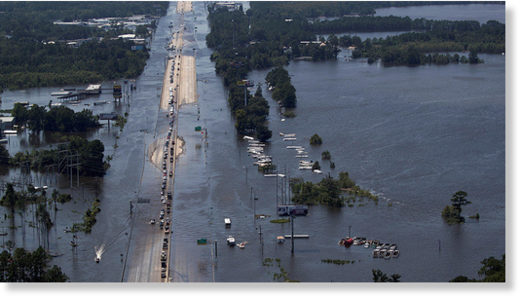
Vehicles on Interstate 10 navigate through flood waters caused by Tropical Storm Harvey in Vidor, Texas, U.S. August 31, 2017.
The work began this past weekend with the military using low-flying C-130 cargo planes to douse three counties with Naled, an organophosphate (OP) insecticide, according to Reuters.
"Due to the large amount of standing, polluted water, populations of pest insects that can transmit diseases are increasing significantly," Captain Jeff Kelly, Air Force spokesman said in a statement. "This poses a health risk to rescue workers and residents of Houston."
It's intended that the spraying will prevent mosquito-borne diseases and prevent emergency response slowdowns by workers inundated by biting insects.
Hurricane Harvey, which began as a Category 4 storm, dumped more than 40 inches (1,000 mm) of rain on parts of Texas over the course of four days. The resulting floods affected hundreds of thousands of homes, displacing more than 30,000 people and prompting more than 17,000 rescues.
Naled, a neurotoxin sold under the brand name Dibrom, works by killing an enzyme in insects and leads to overstimulating the nervous system, causing nausea, dizziness and confusion and at high exposure, respiratory paralysis and death.
Naled has been widely used in the US since 1950, but it was prohibited for use by by the European Union in 2012 over concerns it might affect human health.
"The scenarios evaluated in the human health risk assessment as well as in the environmental risk assessment showed a potential and unacceptable risk," the EU wrote about its decision.
The UN classifies the insecticide as a 6.1 inhalation hazard.
However, the US Centers for Disease Control and Prevention and the US Environmental Protection Agency support the use of the insecticide and say that small amounts don't expose people enough to pose a health concern. The US Air Force agrees.
Comment: Does anyone actually trust these agencies anymore?
"The system disperses droplets small enough to land on a mosquito's wing, using less than one ounce of naled per acre. That's less than one shot glass for an area the size of a football field," an Air Force spokesperson said.
Naled is used elsewhere in the US, with health departments spraying about one million pounds on 16 million acres each year - especially after disasters like hurricanes and flooding - to curb mosquitos. About 70 percent is used for pest control, while around 30 percent is used in agriculture for cotton production in California and Louisiana, on alfalfa in Idaho and Oregon, and on grapes in California.
The military has used its aerial spray missions before, following the 2005 Hurricanes Katrina and Rita, which heavily damaged the Gulf Coasts of Louisiana, Mississippi and Texas.
Though the US government considers naled safe, experts have found potentially dangerous side effects.
In 2016, naled spraying caused millions on honeybee deaths in South Carolina. It is now understood that it is better to spray during dawn and dusk, when bees are normally in their hives.
Pesticide Action Network (PAN) states that long-term impacts of Naled exposure can be serious - particularly for children - as it is a hormone disruptor and a reproductive and developmental toxin.
Many studies have also linked prenatal exposure to OP pesticides to neurological harms, including increased risk of autism and reduced IQ levels, as it may cross the placenta if it is in the bloodstream of a mammal.
In 2016, a study from researchers at the University of California, Berkeley found that when pregnant mothers live within one kilometer of fields where certain pesticides are used, their children are more likely to have lower IQs.
Other species are also affected. A University of Florida zoologist, Tom Emmel, studied areas in Florida where the regular mosquito spraying occurred with Dibrom and another insecticide. He found a "major loss" in insect diversity in sprayed sites with wasps showing "some of the most dramatic drops in species diversity, whereas scale insects increased."
Naled is also considered moderately toxic to birds and most aquatic life. The mule deer, however, is among those most resistant to its effects.


Comment: They're spraying toxic chemicals, plain and simple--the only debate is: how toxic are they? One way or another, it sounds like it's best to avoid these sprays if at all possible.